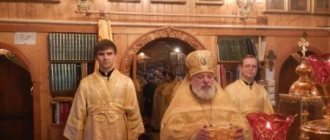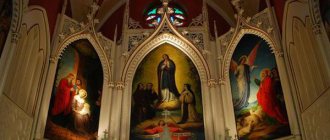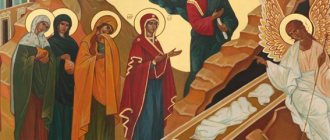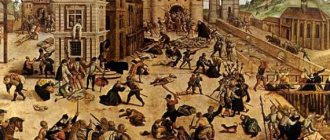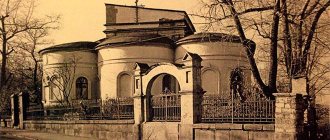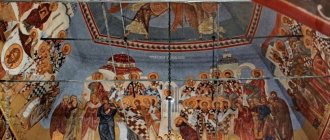A day in history. March 8: Ukrainian Greek Catholic Church liquidated
The Lviv Cathedral of the Ukrainian Greek Catholic Church (UGCC) in March 1946 in present-day Ukraine is usually called exclusively a “pseudo-council” and emphasizes that its preparation and conduct were ensured by the Soviet authorities and state security. Without diminishing the role of the latter, it is still worth noting that the initiators of the council were Greek Catholic priests, who relied on the desire of their parishioners to return to Orthodoxy.
A mass movement for the return of Uniates to the fold of the Orthodox Church existed even in interwar Poland. Dozens of Greek Catholic parishes (about 60 thousand believers) in Galicia converted to Orthodoxy during the period between the world wars - this is something that people in Lviv really don’t like to remember today.
In the Greek Catholic Church, Father Gabriel Kostelnik, a prominent theologian and philosopher, enjoyed enormous authority, who since the 1920s advocated the return of the Uniates to Orthodoxy, constantly wrote on this topic, and gave arguments in defense of his opinion. It was he and his associates who later formed the initiative group that prepared the Lviv Cathedral.
For me, this is practically part of family history, since it was Father Gabriel who baptized my mother in the summer of 1943 in Lvov.
At the beginning of 1939, in the Lviv diocese of the UGCC, a group of priests led by Archimandrite Klimenty Sheptytsky discussed the issue of abandoning the union and creating a “Ukrainian People’s Church.” Members of the group were priests Kostelnik, Kowalski, Pritma and others. According to the plan, the head of the church was to become the head of the UGCC, Metropolitan Andrei Sheptytsky, who knew about the work of the group.
A day in history. November 12: the famous preacher of the church union was killed
However, after the annexation of Western Ukraine to the USSR, events took a different direction.
In 1941, the People's Commissar of Internal Affairs of the USSR Beria approved a plan for the operational development and liquidation of the Ukrainian Greek Catholic Church.
The primary task was to separate the UGCC from the Vatican by creating an autonomous or autocephalous Ukrainian church with its subsequent annexation to the Russian Orthodox Church, that is, the new “independent Ukrainian church” could receive the “tomos of autocephaly” not from Bartholomew, but from Lawrence.
However, after the war, the NKVD abandoned the intermediate phase of creating the Ukrainian church and began the direct liquidation of the UGCC through its unification with the Russian Orthodox Church.
In general, the plan was part of a general effort aimed at combating the UPA and OUN and any manifestations of Ukrainian separatism. They recalled the UGCC and its collaborationist policies during the German occupation, as well as the involvement of part of its clergy in Ukrainian nationalist movements.
If Metropolitan Sheptytsky at least formally condemned the atrocities of the UPA, and in 1944 sent an enthusiastic letter to Stalin, welcoming the entry of the Red Army into Western Ukraine, then his successor, Metropolitan Joseph Slipy, was an open opponent of Soviet power.
The situation was aggravated by the fact that at the beginning of 1945, in the speeches of Pope Pius XII, motives of hostility towards the communists and the USSR were heard. In the Catholic Church, ideas arose for creating a confederation of the Danube countries, organizing a Catholic Action Committee to launch a fight against left-wing radical elements, etc.
Under these conditions, the Soviet leadership refused to compromise with the Holy See, which was henceforth characterized as a “defender of fascism” seeking to strengthen its influence in the post-war world. The presence in the USSR of more than 4 million believers, united in a special church controlled by the Roman Pontiff, seemed extremely undesirable to Joseph Stalin.
From union to union. How Ukrainian church separatism could not prevent the rise of the Third Rome
©
from open sources
In 1945, all the bishops of the UGCC were arrested (none of them agreed to convert to Orthodoxy), and the church was actually headed by the elderly Archimandrite Klimenty Sheptytsky (by the way, since October 1939 - the Greek Catholic Exarch of the Apostolic Exarchate of Russia), who also called on priests not agree to transfer to the jurisdiction of the Russian Orthodox Church.
However, on May 28, 1945, an initiative group of Uniate priests led by Gavriil Kostelnik officially took shape, publishing two letters: a request to the Council of People's Commissars of the Ukrainian SSR for its approval and an appeal to the “all-Russian Greek Catholic clergy in the western regions of Ukraine.” The Council of People's Commissars of the Ukrainian SSR, through its commissioner for the affairs of the Russian Orthodox Church, approved the initiative group as “a single temporary church-administrative body of the Greek Catholic Church” with the aim of uniting it with the Russian Orthodox Church.
The culmination of the work of the initiative group was the Council of the Ukrainian Greek Orthodox Church, which opened in Lviv on March 8, 1946 in the Metropolitan Cathedral of St. George. 216 delegates-priests and 19 lay people from the Lviv, Ternopil, Stanislav and Drohobych regions took part in the work of the Council; Archpriest Gabriel Kostelnik presided over it.
By the time of the Council, two members of the initiative group had managed not only to convert to Orthodoxy, but also to become bishops of the Russian Orthodox Church: Anthony (Pelvetsky) - Stanislavsky and Kolomyiasky, and Mikhail (Melnik) - Drohobych and Sambirsky. Participants in the council were also those clergy of the UGCC who reunited with the Orthodox Church in Kyiv back in February. Honorary guests arrived at the cathedral: Metropolitan John of Kiev, Bishop Macarius of Lviv and Ternopil, Bishop Nestor of Mukachevo and Uzhgorod, Archpriest Konstantin Ruzhitsky, manager of the affairs of the Kyiv Exarchate.
At the opening of the Council, Gabriel Kostelnik gave the main report - “On the motives for the reunification of the UGCC with the Russian Orthodox Church,” in which he substantiated the need to abolish the union from historical and theological points of view.
September 7, 1984 Self-proclaimed Uniate Patriarch Joseph Slipyi died
He spoke excitedly and pathetically, and already on the first day the Council adopted the fundamental provisions that formed the basis of its resolutions: to abolish the union of 1596, break away from Rome, return to the ancestral Orthodox faith, reunite with the Russian Orthodox Church.
The next day, in the Cathedral of St. George, 12 priests of the St. George Orthodox Church of Lviv, who had previously reunited with the Orthodox Church, accepted confession from the participants of the cathedral - the Uniates. Then Bishops Macarius of Lvov, Nestor of Mukachevo, Anthony of Stanislav and Mikhail of Drohobych accepted the renunciation of Catholicism from the 204 Greek Catholic priests who participated in the Council, and after reading the prayer of permission, the priests, already reunited with the Orthodox Church, participated in a joint liturgy.
The decisions of the Council were supported by 997 of 1,270 Greek Catholic priests in Western Ukraine, the rest were condemned or went underground, and their parishes were closed. By the way, it was one of the priests of the so-called “Catacomb Church” who baptized me in the summer of 1968 in a field near the village of Mokrotyn near Zholkva.
What is noteworthy is that the Soviet government stimulated the transition of Greek Catholic parishes to Orthodoxy not only by direct repression, but also by economic methods: since 1945, Orthodox parishes were taxed no more than 25%, united around the initiative group of the Greek Catholic Church to reunite it with Orthodoxy - 40%. , and Greek Catholic parishes and monasteries - 100% of the maximum tax rate.
The Ukrainian Greek Catholic Church did not recognize the Council as legitimate, justifying this by the fact that not a single one of its bishops was present at it, three members of the initiative group, shortly before the Council, switched to the Russian Orthodox Church (that is, at that time they were no longer Catholics), and the Council was prepared and administered by directives from secular authorities.
Despite this, the canonicity of the cathedral was later recognized by all Local Orthodox Churches of the world.
A day in history. February 26: The godfather of Maidan was born
It is worth recalling that at the conclusion of another union, the Union of Uzhgorod, in 1646, half a century after the Brest Union, 63 Orthodox priests took part in this action, but there was not a single bishop. However, in relation to this case, Greek Catholics for some reason do not talk about non-canonicality. By the way, it was in the spirit of the resolutions of the Lviv Council that the liquidation of the Greek Catholic Church in the Transcarpathian region of Ukraine took place (1946-1949). According to UNKGB reports, the population of Galicia perceived reunification with the Orthodox Church as a whole neutral or positive.
Part of the Western Ukrainian intelligentsia reacted negatively to the decision of the Lvov Council of the UGCC, who believed that the liquidation of the UGCC was a way to bring Western Ukraine closer to the position in which the rest of the USSR had been for many years, and to strengthen ties with Moscow. Some representatives of the Ukrainian intelligentsia saw this as an attempt to Russify the Ukrainian church and an attack on Ukrainian culture.
The attitude of the OUN* towards the liquidation of the UGCC was sharply negative; when assessing the Council, the organization emphasized the political motives of this event, held under the patronage of the NKGB.
After the Council, Gabriel Kostelnik delayed the transfer of powers to lead the church to the Orthodox Bishop Macarius and tried in every possible way to strengthen his influence among former Greek Catholics, accepting Uniate priests from the Lvov, Ternopil, Stanislav and Drohobych dioceses in the office, declaring: “Without us, there will be no Orthodoxy in Galicia.” .
In this regard, the NKGB intended to transfer him to a new duty station in Kyiv, under the Exarch of Ukraine, paralyzing attempts to further govern the former Uniates.
A day in history. March 5: UPA commander* eliminated
©
Public domain
However, Kostelnik’s transfer, for unknown reasons, never took place, while in 1946-1947, in connection with the threat of actions from the OUN*-UPA*, the NKGB took secret measures to protect Gabriel Kostelnik.
During his stay in Moscow in April 1946, he was elevated to the rank of protopresbyter - the highest honor for the white (married) Orthodox clergy, and in July 1948, Kostelnik took part in the celebrations in connection with the 500th anniversary of the autocephaly of the Russian Orthodox Church, held in Moscow .
On September 20, 1948, after a service in the Transfiguration Cathedral in Lvov, on the way home, Protopresbyter Gabriel Kostelnik was killed by two shots from a pistol. The killer was surrounded by a crowd of believers and shot himself; he was later identified as Vasily Pankiv, a member of the group led by Roman Shukhevych, although representatives of the OUN*-UPA* denied any involvement in the murder.
An official notice in the organ of the Moscow Patriarchate, signed by Metropolitan Nikolai (Yarushevich), stated that Kostelnik was “killed by an agent of the Vatican.” In 1998, the official body of the Moscow Patriarchate called his death a “martyr’s death.”
By that time, the UGCC had emerged from underground for almost ten years, had regained most of the churches lost after 1946, and was actively expanding to the East. However, it was never possible to completely destroy the fruits of the activities of Gabriel Kostelnik and the Lviv Cathedral: until now, about a third of the inhabitants of Western Ukraine consider themselves Orthodox. And although many of them belong to non-canonical communities - the “Ukrainian Orthodox Church of the Kyiv Patriarchate” and the “Ukrainian Autocephalous Orthodox Church”, now united in the so-called OCU - these people did not want to return to the Uniate tradition.
References
- Ukraine remembers the visit of John Paul II, Zenit News Agency, June 2006.
- Ukraine responded to the Pope's visit, Ukrainian Religious Information Service
- ^ a b Sixteen years is a short period to learn charity, Interview with the head of Caritas-Spes in Ukraine, RISU Portal, September 2007.
- News from the portal of the Catholic hierarchy
- Parafial newspaper (Roman Catholic newspaper), N 24, December 2007, in Ukrainian.
- Catholicism in Ukraine, website of the Religious Information Service of Ukraine
- Catholic Directory
